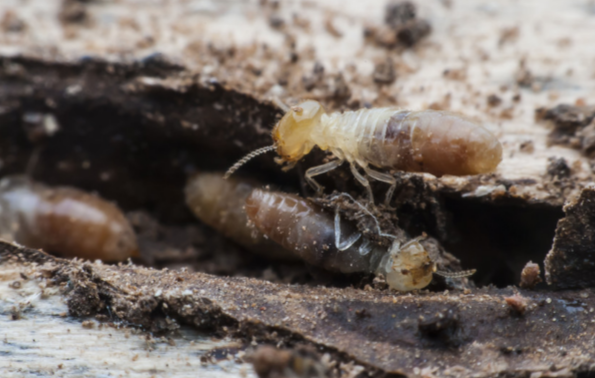
Formosan Termites
Formosan termites have been found in the Gulf Coast states, along the eastern seaboard north to North Carolina, as well as in Tennessee, California and Hawaii. Formosan termites are imported pests that are 1/2 inch long, larger than the native subterranean species. The winged reproductives are pale yellow to brownish yellow, and the hairy wings have two dark veins at the leading edge. They have a small pore (i.e., fontanelle) on the front of their heads. The soldiers are easily distinguished from other subterranean termite soldiers because they have an oval head with massive toothless mandibles that cross at the tips.
Biology
Formosan termites are subterranean termites that usually live in the ground, build mud tubes and construct carton nests, consisting of soil and wood cemented together with saliva and feces. Swarms appear on warm and rainy days around dusk and continue into the evening. The swarmers are attracted to light. A mature queen produces 1,000 eggs per day. An average colony consists of 350,000 individuals, but colonies that contain millions of individuals are not uncommon.
Habits
This is the most destructive termite species, which infests structures within the United States. These termites are very industrious, easily overpowering the native species in tunnel building and destruction of wood. An average size colony consumes 14 linear feet of pine studs in one year. In three months they can cause extensive damage to wood in structures. Their cartoon nests retain moisture and enable colonies and satellite colonies to establish aerial nests and survive without maintaining contact with the soil. Workers in a colony may forage over an area more than one acre in size and travel almost 400 feet to a food source.
Control
Control of Formosan termites begins with a thorough inspection to determine the extent of the infestation, the points of entry into the structure, moisture problems and other contributing factors, and the development of a control plan. The initial step in subterranean termite control is to remove any scrap wood, firewood or any other wood materials in contact with the soil. There should be at least six inches between soil in a crawl space and the floor joists. Water leaks and situations where there is more than 15% wood moisture content must be corrected. Drainage around the structure should be designed so that there is no accumulation of water near the foundation. Situations contributing to this condition include poor exterior soil grades, planter boxes, sprinkler systems, air conditioner condensate drains, lack of gutters, gutter downspouts, etc. Mechanical alterations and removal of infested wood and replacement with treated wood is useful, but it does not usually stop the termites from gaining access to wood in the structure.
Formosan termites are controlled in the same manner as other subterranean termites: establish a repellent termiticide barrier in the soil and prevent the workers from foraging for food from the colony in the soil to wood in the structure. Soil treatments do not last indefinitely and any disturbance of the soil barrier can result in reinfestation. The recent development of termites baits offers an option for eliminating the colony using an insect growth regulator or slow acting toxicant, but this technique does not immediately stop termite foraging activity within the structure.